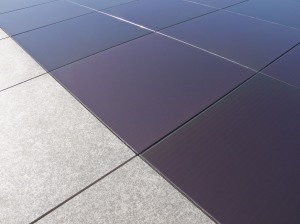Onyx Solar has collaborated with Butech, Porcelanosa’s subsidiary focused on materials and constructive systems development, in the creation of the first PV pavement which is expected to be in the market by the end of the year. This innovative product was introduced at Porcelanosa’s Annual Show in February and turned out to be one of the main attractions of the show, the largest ever in terms of attendees. Porcelanosa is one of the world’s leading manufacturers of high-end ceramic tiles and kitchen-and-bath products. Onyx Solar is specialized in the integration of solar photovoltaic solutions in buildings.
 This cutting edge system, which is still in an early development stage by Onyx and Butech engineers, is made by a solar PV glass integrated over elevated ceramic and it´s completely walkable. One of its main atractives is the versatility and the fact that it is posible to place furnishing on it without losing space.
This cutting edge system, which is still in an early development stage by Onyx and Butech engineers, is made by a solar PV glass integrated over elevated ceramic and it´s completely walkable. One of its main atractives is the versatility and the fact that it is posible to place furnishing on it without losing space.
The pavement combines pasive elements (avoided CO2 emmissions) with active elements (power generation) reducing remarkably the impact of the building on the environment.
But the PV pavement is not the only Project in which Onyx Solar is working alongside Porcelanosa’s subsidiary. They are also working on a PV façade developed by both companies which, unlike the pavement, is already available and being installed in projects all over the World.
